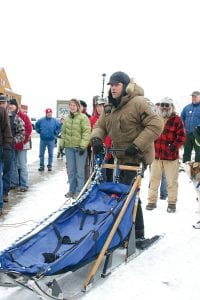More than 100 well wishers were on hand in the Grand Marais Harbor Park to help send off Frank Moe on his sled dog run to the capitol where he presented Governor Mark Dayton with petitions from Minnesotans who are opposed to non-ferrous mining. Moe and a group of Cook County residents are joining together to make a film about Moe’s run to the capitol. The film should be released sometime in November.

Last March Colvill musher Frank Moe and his team of 10 sled dogs left Grand Marais and made their way to Saint Paul where Moe delivered over 13,000 petitions to Governor Mark Dayton from Minnesotans opposed to non-ferrous metals mining in northern Minnesota.
All told, Moe spent eight days on the trail meeting people and gathering petitions as he covered 362 miles on his circuitous route to the capitol.
Moe said the purpose of the trip was to, “Inform Minnesotans about the potential hazards of the sulfide mining projects proposed for Northeastern Minnesota.”
While the governor, who has yet to take a position on proposed non-ferrous metal mining, was reluctant to meet with Moe, he certainly hasn’t heard the last from him. Moe has raised $17,241 from 173 backers and is now in the process of making a documentary about his trip. The film will use pictures and videos Moe shot along the way and is targeted for a November 2012 release.
The first of two proposed non-ferrous metal mining projects for Northern Minnesota, are near Ely and Hoyt Lakes. If developed, the mine in Ely is expected to generate 80,000 tons of ore per day making it one of the three biggest mines in the world. The mine near Ely will be located three miles away from the Boundary Waters Canoe Area. The mine proposed near Aurora-Hoyt Lakes is in the St. Louis River watershed.
When the mining companies extract copper, nickel, silver or other metals, sulfide minerals can generate acidity when exposed to oxygen and water. This acidity is commonly referred to as acid rock drainage (ARD). According to a Mining Minnesota article by Frank Ongaro, executive director of Mining Minnesota, if ARD is left uncontrolled, it can reach streams or groundwater. According to Ongaro, preventing and treating ARD can be done successfully. He wrote that preventing oxidation of sulfide minerals is a critical step toward mitigating the environmental impacts of mining sulfide ore bodies.
Ongaro said he believes that science has evolved to the point that minerals from a sulfide ore body can be analyzed from core samples to determine if material has the potential to generate ARD before it is excavated from the ground. He said that information could then be used to prevent the occurrence of ARD or to contain it.
Moe and the members of the non-profit group Sled Dogs to St. Paul, disagree. They say to date there has never been a sulfide mine that hasn’t caused a great deal of pollution.
Moe said Sled Dogs to Saint Paul was formed to spread the word about the potential dangers of these mines.
“We decided to go for broke and do a Kickstart Campaign. That meant we had 30 days to raises the whole $17,000 we needed to produce the movie. With five days to go we still needed to raise over $12,000. Then it took off. On the last full day of the campaign we raised $4,000. Almost all of that coming from the Grand Marais area.
“Cook County cares about clean water, period,” Moe said.
Moe is pleased to announce the soon-to-be released Sled Dogs to Saint Paul: The Race for Clean Water, which he said, “is going to be a total Grand Marais area production.”
Working on the film are Staci Drouillard, Stephan Hoglund, Ann Possis and filmmakers Kelly Schoenfelder and Patrick Knight.
“They plan to have the film done in early November and it will premier in Grand Marais,” Moe said.
Moe is no neophyte to the political arena, having served two terms in the Minnesota House (2004-2008) as a DFL representative from Bemidji.
Before serving in the legislature, Frank taught environmental studies at Bemidji State University. In 2008, after leaving the legislature, Moe received a Bush Fellowship to study outdoor education issues with an emphasis on how to better engage young people in outdoor experiences and conservation issues.
Moe has a B.A. from Carleton College and an M.A. from the University of North Carolina. He is currently working— slowly—on his doctorate in Recreation, Park and Leisure Studies. He and his wife Sherri live in Colvill with their team of 38 sled dogs.
Learn more at:
. MiningTruth.org
An online resource developed by Conservation Minnesota, Friends of the Boundary Waters Wilderness and the Minnesota Center for Environmental Advocacy (MCEA) “for sulfide mining-related news and information.”
. MiningMinnesota.com
An initiative “driven by a diverse coalition of organizations, companies and individuals committed to sustainable and environmentally responsible critical and strategic metals mining development in Minnesota.”
. Twin-Metals.com
A biweekly “source of information about its proposed underground copper, nickel, platinum, palladium and gold (strategic metals) mining project in northern Minnesota.
. WaterLegacy.org/sulfide_ mining
A “grassroots citizens’ group formed in response to the threat of the first sulfide mine proposed in the State of Minnesota.”


Loading Comments